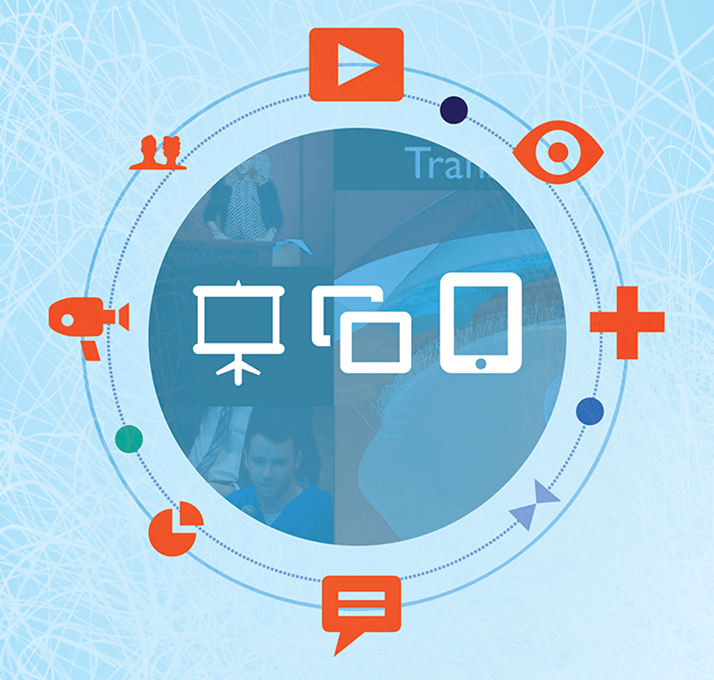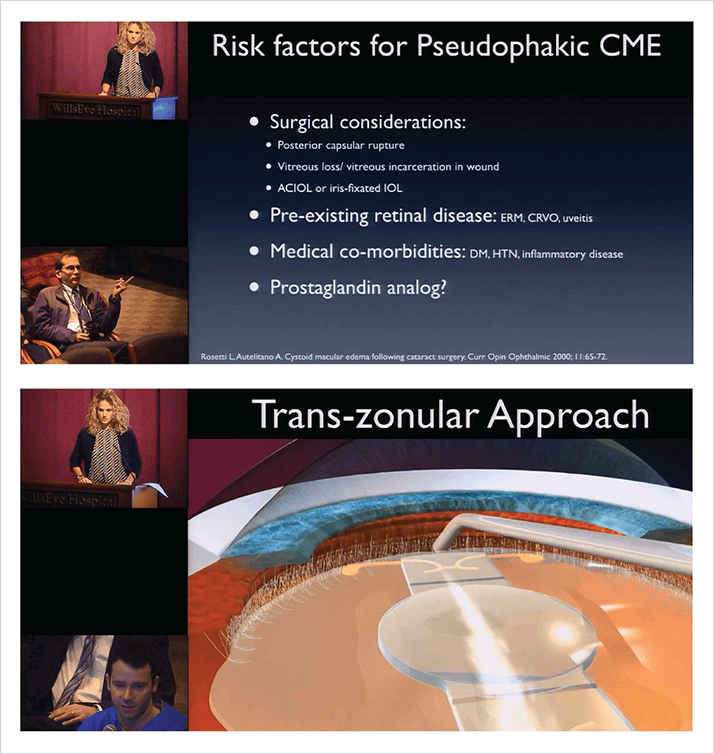
- Every Friday, Philadelphia’s Wills Eye Hospital stream their Chiefs’ Rounds live to an international audience
- Virtual attendance counts towards CME, and remote viewers can send in questions afterwards about the cases presented
- Broadcasting live to the world isn’t easy – in essence, the auditorium has to become a TV set, complete with microphones, cameras and lighting
- The livestreaming of Chiefs’ Rounds has grown in popularity, with many ophthalmologists from around the world tuning in each week
On Fridays, when the faculty at Wills Eye Hospital gather for Chiefs’ Rounds – an opportunity for the residents to present complicated cases to the faculty that attend – the cameras start rolling, and the meeting is streamed live online, where it can be freely accessed. We spoke with Wills Eye’s Ophthalmologist-in-Chief, Julia Haller (JH) and Director, Media Technology Services, Jack Scully (JS) to understand why they’ve embarked upon this enterprise, and what it brings to ophthalmologists across the globe.
So what gave you the idea to turn Chiefs’ Rounds at Wills Eye into a live webinar?
JH: We’ve had a robust educational program at Wills ever since the first ophthalmology resident was trained in the United States back in 1839. Teaching is a part of our DNA. But it wasn’t until about 10, 15 years ago that we started thinking about putting more of our educational material online. It started with a program that we had involving the Department of Defense, during the invasion of Afghanistan. We put a lot of our lecturers online for ophthalmologists and eye care providers in the military to view, as they were finding it increasingly hard to attend medical education programs. People liked it so much that back in 2007/2008, we decided to expand the Wills Eye Knowledge Portal, as we call it, because of the feedback. More recently, we started interactively streaming Chiefs’ Rounds on Friday mornings. At first we had just eight people watching the rounds, and now it’s over 150. Word is spreading, and it’s so great to hear people telling us how much they enjoy it, and that it’s changing their practice.So how does it work?
JH: It’s an interactive program where residents present complicated cases to the faculty and ask them questions. So a typical session would be a resident presenting a case, for example, a 55-year-old lady who had cataract surgery a month ago and then came to the emergency room with blurry vision. So the resident will show pictures, then perhaps pick someone in the audience (probably a cataract surgeon) and ask, what do you notice about this patient? What tests would you order? What might your differential diagnosis be? And what’s unique is the interaction – you’re not just listening to just one expert talking about his or her area of expertise, you have a whole room full of some of the top specialists in the world, discussing these cases together. It’s spontaneous – our whole faculty is there throwing ideas around. For people outside, it’s an opportunity to see arguably the top clinical practitioners in the world discussing cases, including many systemic and life-threatening diseases. They’re tricky cases, and everybody wants to solve the mystery with us as our program unfolds, so it’s a bit like Sherlock Holmes.
What facilities do you need to be able to livestream?
JS: Over the years, we’ve built up the infrastructure in our auditorium for this purpose. We’ve put up curtains behind the podium, wired the room for sound, improved the lighting, and mounted new, better cameras above the podiums so we can film the audience. And there’s a speaker camera in the back – so we had to upgrade significantly to make this possible. JH: In the past, you could just see the resident presenting the case and the slides, but now the audience is visible too – this is a little more nerve-racking because we have to consider how we look and sound, as we’re going to be streamed on the Internet worldwide! But having the audience visible has made it a much more interactive experience – it gives you a feeling of what it’s like to be at Wills in real time.It must be quite a technical feat…
JS: Well, there’s a lot going on in our control room on Friday morning! I’ve been here for 30 years and I consider the live Chiefs’ Rounds to be the most important part of the day. We have to make sure it goes off without a hitch. And we’re also recording it for the Knowledge Portal. I have a smaller job too, which is making sure everyone has a mike in their hand and is using it – these things make such a difference for our audience.JH: Yes, at first it was a challenge to get people to speak into the microphone, and that could make them hard to hear. Jack and Bill Romano are very detail-oriented and keep everything running smoothly. It’s like synchronized swimming – on top it looks so graceful, but underneath the water their feet don’t stop moving. We’re essentially putting on an unscripted, unrehearsed television show. JS: Which can be scary sometimes!
And ophthalmologists are awarded CME credits for attending the virtual rounds?
JS: Well I’m not an expert, but if your country allows you to use ACCME credits you can get them. We get analytics on the webinar, so we know who has attended and it tells us if they attended for the full length of our Chiefs’ Rounds. They can then contact our CME department which issues the Accreditation Council for Continuing Medical Education (ACCME) credit to that individual for attending. I think that is part of the draw. JH: If you’re a practicing ophthalmologist, it’s a free way to get credits if you need them. But I also think it transcends that. Many people in residencies and training programs overseas, who don’t need American CME credits, also tune in.Can people viewing remotely join in and ask questions?
JS: Chiefs’ Rounds take place every Friday from 7.00 to 8.00 am EST. As soon as we’re done, our doctors are hitting the clinics and the OR, and starting their busy day. We would love to be able to take live questions during rounds, but the logistics of that would slow them down, which we can’t do. But questions do come in, and we take them and email them to the presenting residents, who usually reply with their answers.It must be a lot of work. What are the benefits?
JH: Well, we get responses from people who say, we benefited from this tremendously, and we got tips for taking care of our patients. So goodwill, reputation, and a way to stay in contact – for example, the chief at the Mayo Clinic is a former fellow here, and he and his wife get up in time to watch it every week, and tell us how much they like it. JS: I think it’s also the culture at Wills – we want to share what we learn. If we get benefits from that, fantastic, but even if we don’t, it’s important to teach the next generation of ophthalmologists, and interact with ophthalmologists around the world. As Julia said, it’s in our DNA. JH: And it’s just such a fun way to learn.Julia Haller is Ophthalmologist-in-Chief and Jack Scully is Director, Media Technology Services at Wills Eye Hospital, Philadelphia, USA. The Live Streaming of Chiefs’ Rounds is available here: http://top.txp.to/0615/willseye
